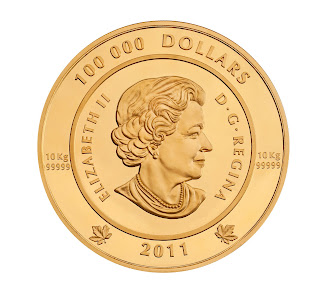The Royal Canadian Mint has issued the 2011 Highway of Heroes Silver Commemorative Coin which celebrates a grassroots movement responsible for honoring Canada's fallen servicemen and servicewomen known as the Highway of Heroes. A $20 surcharge on the sale of each commemorative coin will be forwarded to the Afghanistan Repatriation Memorial and the Military Families Fund.
Each coin is struck from 99.99% pure silver and features a face value of $10. The Mint indicates that the maximum mintage of the strike will be limited to only 25,000 coins.
The somber yet heartening story of the Highway of Heroes goes back almost a decade. It started in 2002 when crowds of Canadians gathered at the overpasses of a section of Highway 401. They joined together to honor the first of Canada's fallen soldiers whose bodies were being returned from the conflict in Afghanistan.
This tradition has continued to this day with crowds still lining the overpasses to pay their respects to the fallen individuals as well as their families as they pass underneath. The bodies of the soldiers are being taken from Canadian Forces Base Trenton to Toronto.
A Memorial Cross is shown to the upper left. Reverse inscriptions include "CANADA," "10 DOLLARS" and "2011."
The commemorative coin is struck as legal tender of Canada and features an image of Queen Elizabeth II of England, as designed by Susanna Blunt. Obverse inscriptions include "ELIZABETH II" and "D G REGINA."
Each 34mm Highway of Heroes strike weighs 15.87 grams. The commemorative coin is available now directly from the Royal Canadian Mint with additional information available at www.mint.ca/heroes.
Boscastle Supplies has a full inventory of coin albums
Each coin is struck from 99.99% pure silver and features a face value of $10. The Mint indicates that the maximum mintage of the strike will be limited to only 25,000 coins.
The somber yet heartening story of the Highway of Heroes goes back almost a decade. It started in 2002 when crowds of Canadians gathered at the overpasses of a section of Highway 401. They joined together to honor the first of Canada's fallen soldiers whose bodies were being returned from the conflict in Afghanistan.
This tradition has continued to this day with crowds still lining the overpasses to pay their respects to the fallen individuals as well as their families as they pass underneath. The bodies of the soldiers are being taken from Canadian Forces Base Trenton to Toronto.
"This silver coin commemorates the spontaneous outpouring of emotion by thousands of Canadians who have gathered along the roadway and overpasses of the Highway of Heroes to pay tribute to the brave Canadian men and women who have made the ultimate sacrifice," said Ian E. Bennett, President and CEO of the Royal Canadian Mint. "The Highway of Heroes commemorative coin also continues the proud Mint tradition of issuing coins that honor Canada's veterans and the theme of Remembrance."Shown on the reverse of the commemorative coin is a design by Royal Canadian Mint engraver Stan Witten, in collaboration with Major Carl Gauthier. It shows one of the overpasses of the Highway of Heroes filled with individuals who have come of their own accord to honor the fallen soldiers and their families. Many Canadian flags are shown draped over the side of the overpass indicative of the strong pride the gathered have for their country. Behind them, a large maple leaf is depicted.
A Memorial Cross is shown to the upper left. Reverse inscriptions include "CANADA," "10 DOLLARS" and "2011."
The commemorative coin is struck as legal tender of Canada and features an image of Queen Elizabeth II of England, as designed by Susanna Blunt. Obverse inscriptions include "ELIZABETH II" and "D G REGINA."
Each 34mm Highway of Heroes strike weighs 15.87 grams. The commemorative coin is available now directly from the Royal Canadian Mint with additional information available at www.mint.ca/heroes.
Boscastle Supplies has a full inventory of coin albums






